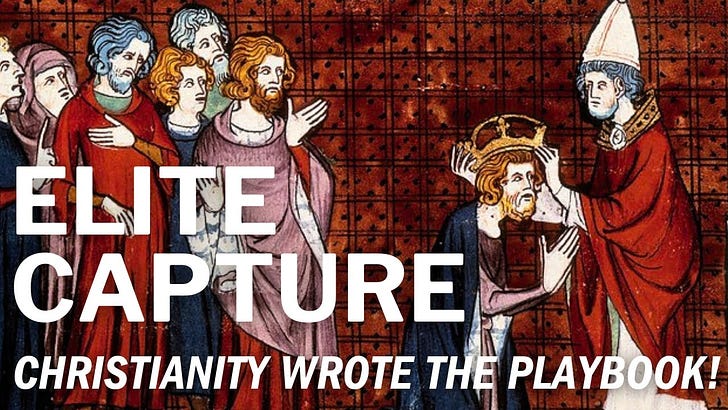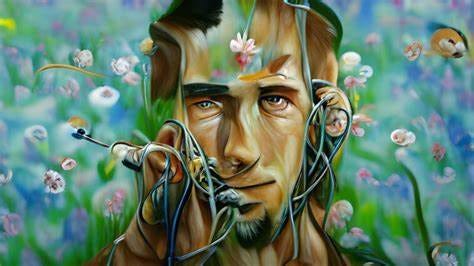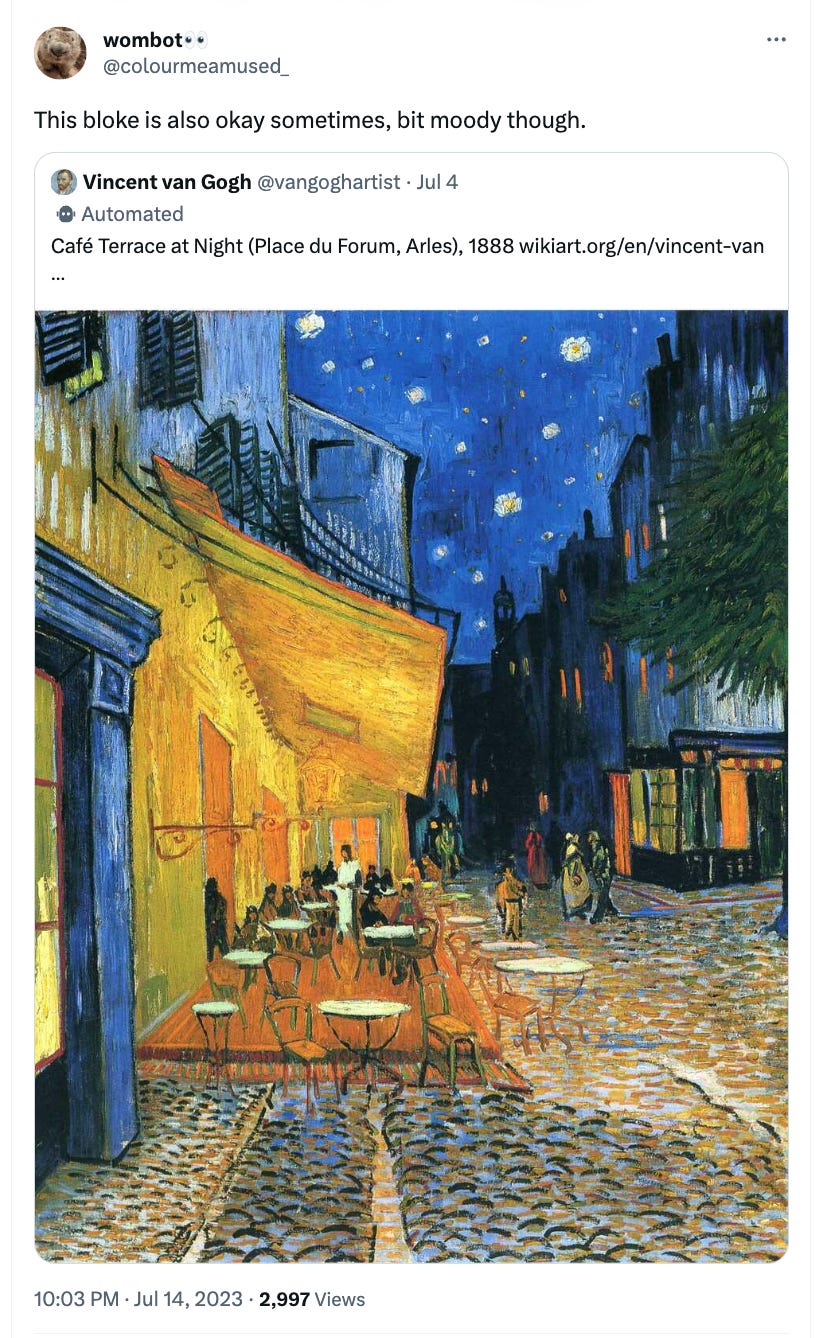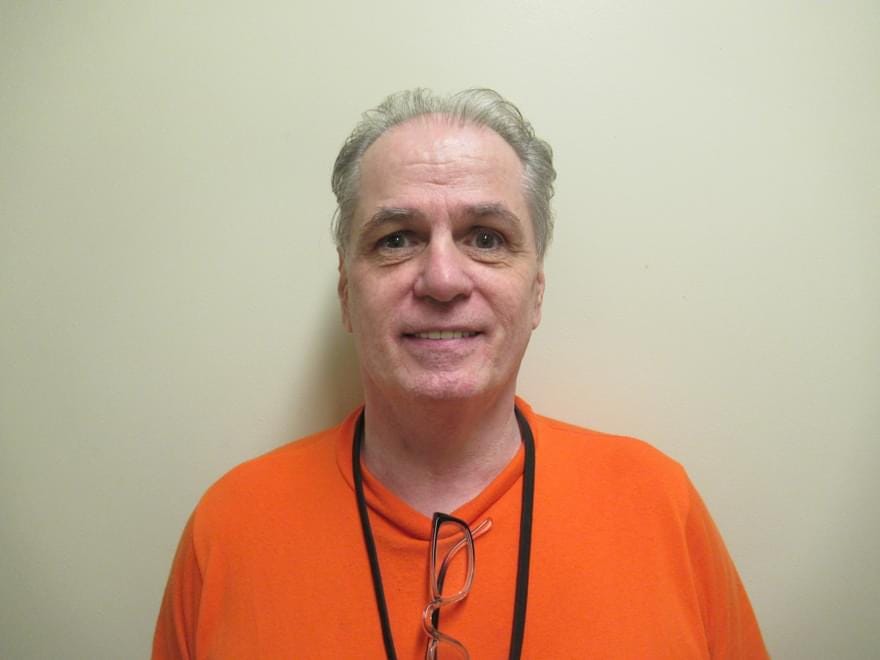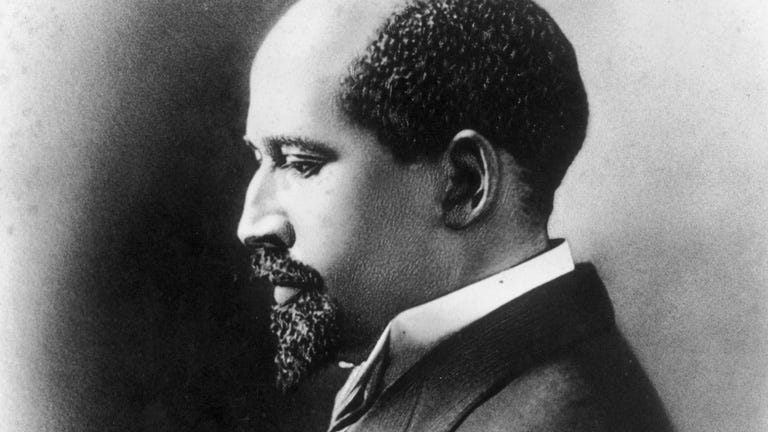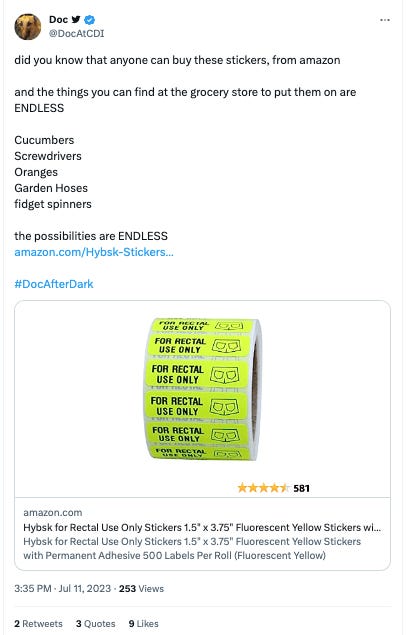Elite capture: Christianity wrote the playbook
And other great things I found on the net (and in my email intray) this week
Elite capture: How Christianity wrote the playbook
Of all the podcasts we’ve done so far, this is my favourite.
We discuss Peter Heather’s marvellous book “Christendom: the triumph of a Religion”. It covers the thousand years from the time Christianity becomes embedded in the Roman Empire, via Emperor Constantine’s conversion. Heather’s book shows how much Christianity was spread not by those ‘meek’ whom Jesus would have inherit the earth, but by the powerful for whom conversion offered improved relations with the Emperor’s court. Over time, and through the period of Charlemagne it infiltrated European life via various drives for Christian piety.
By the 12th century, the Church had deeply infiltrated people’s lives through the seven sacraments — which marked the weekly rhythms and major milestones of people’s lives — they included baptism, confirmation, the eucharist, penance, and marriage. And by the 12th century, the church was in many ways more powerful than any king or emperor. It controlled Europe’s operating system — it’s systems of information and learning and its transnational legal code. The church is also the template for a specific organisational form. The church was a unitary organisation governed by a monarch supported by a skilled bureaucracy administering an elaborate and time-honoured legal code. Nation states took their form from the church. So too, later on did corporations.
If you prefer the audio file, it’s here.
Integrity is paramount for this government
Only kidding! HT: Tim Dunlop
Nick Cave’s idea of a good conversation
Mine too. HT: Eva
Dear Laura and Ray,
A good faith conversation begins with curiosity. It looks for common ground while making room for disagreement. It should be primarily about exchange of thoughts and information rather than instruction, and it affords us, among other things, the great privilege of being wrong; we feel supported in our unknowing and, in the sincere spirit of inquiry, free to move around the sometimes treacherous waters of ideas. A good faith conversation strengthens our better ideas and challenges, and hopefully corrects, our low-quality or unsound ideas.
I have learned that it's best to retract, disengage and to change the subject once a conversation ceases to be in good faith. In general, I have found it to be a waste of time to expend too much energy on someone whose mind is fully made up, who does not understand the nature of conversation and the true value of disagreement. To me, it seems a kind of inverse metric often applies to these kinds of conversations - the shriller, more strident and more certain your interlocutor, the less they tend to know on the subject. I say this with a fair amount of discomfort because there are times when I have been that self-righteous person. Who hasn't? Who hasn't felt that near erotic charge when the wind is in the sails of a subject we know little about? As we grow into ourselves, hopefully we learn the folly of that.
A good faith conversation understands fundamentally that we are all flawed and prone to the occasional lamentable idea. It understands and sympathises with the common struggle to articulate our place in the world, to make sense of it, and to breathe meaning into it. It can be illuminating, rewarding and of great value -a good faith conversation begins with curiosity, gropes toward awakening and retires in mercy.
Love, Nick
The Archbishop of Canterbury interviews Nick Cave
AI: The copyright wars have begun
Copyright law has never been fit for purpose. Its period of duration is way too long (Imagine a novelist being stirred to write another book so their grandkids could make $3 a year.) And there are oodles of fair uses of people’s copyright that do a lot of good to the copier and their audience and no harm to the creator of the content. And there are all kinds of weird exceptions — like orphan works — that lawyers take a special pride in discussing. They hold whole conferences on it, when there’s nothing more to be said other than that if it’s impossible to determine who owns the copyright, then copyright should lapse or at the very least any user should have safe harbour against any revival of copyright.
Anyway, as Joshua Gans observes, the copyright maximalists were always coming for AI.
Comedian Sarah Silverman and others have launched a class action suit against OpenAI and Meta for copyright infringement. From The Verge:
Comedian and author Sarah Silverman, as well as authors Christopher Golden and Richard Kadrey — are suing OpenAI and Meta each in a US District Court over dual claims of copyright infringement.
The suits alleges, among other things, that OpenAI’s ChatGPT and Meta’s LLaMA were trained on illegally-acquired datasets containing their works, which they say were acquired from “shadow library” websites like Bibliotik, Library Genesis, Z-Library, and others, noting the books are “available in bulk via torrent systems.” …
I read the complaint but, curiously, it showed no examples of ChatGPT, say, using the content of these books. It seems like that would be easy to do. But the allegation is careful. It contends this material was used in the training dataset. …
So what are we to conclude from this? Either ChatGPT is so well constructed as to not divulge information about copyrighted material unless it is also conceivably in the public domain and so it could have been trained using these books OR it wasn’t trained using this book and is telling us all that it knows. Ocaam’s Razor favours the second explanation at the moment.
Mapping the brain

Well folks, judging from this article, we have a breakthrough. It’s a little concerning that the article says that this “will shake the world of science and medicine in the way the sequencing of the human genome did”, just because getting the genome mapped was supposed to lead pretty directly to lots of cures which it hasn’t. It’s led us directly to understanding just how complicated and context dependant things are. But it does sound pretty exciting.
It would fundamentally change the way neuroscience is done, Bates said, because it would allow researchers to see how different parts of the brain speak to each other. For example, if doctors knew that a specific brain region was damaged by a disease, they could easily look at the connectome to see what other areas were linked to the damaged area. They would be able to come up with hypotheses about diseases and dysfunctions more quickly and easily. For instance, Bates said, people have a good understanding of the physiology of the heart because it’s been dissected and its parts studied.
Right now, scientists can scan brains with techniques like fMRI (functional magnetic resonance imaging) which shows what areas of the brain light up when a person is doing a particular task or thinking about something, which is a very crude level of resolution compared to what a connectome could reveal.
A future human connectome could also be a beacon for mental health research, because researchers suspect that many mental health disorders are caused by disruptions in neural connections, Jefferis said. Identifying those disruptions, and which parts of the brain they occur in, could be a launchpad for new kinds of mental health treatment.
The next step toward such transformative technology is breaking ground in the mammalian world. Neuroscientists are “dreaming” about a mouse connectome, Jefferis said, which itself would be a great leap.
For the time being, the fruit fly scientists, called the Drosophila community, are abuzz with the impact of the new connectome. According to Wanner, there are 40 to 60 labs currently working with the new map, and it has already become an “extremely valuable tool.”
Masterpieces from Sienna


Martin Wolf’s suggestion: tone down the hypocrisy — SHOCK!!
One must applaud [Yellen’s] effort to clarify objectives, improve transparency and deepen relations. We must not stumble into hostilities with China as we have done with Russia. Better still, we need to make this relationship work in the interests of the world. Yet the west’s concerns must not be limited to relations with China. Better relations with the rest of the world also matter. This requires the west to recognise its own double standards and hypocrisy.
Russia’s invasion of Ukraine was a dreadful violation of fundamental moral and legal principles. Many in developing countries also recognise this. But they remember, too, the long history of western countries as imperialists and invaders. Nor do they fail to realise that we care far more about fellow Europeans than about others. Too often, we have viewed grave violations of human rights and international law. Too often, we have viewed such injustices as no concern of ours. Ukraine, many feel, is no concern of theirs. …
Yet another significant issue is international assistance. Developing countries have been buffeted by a series of shocks for which they were not responsible: Covid, the subsequent sharp rise in inflation, the invasion of Ukraine, the jump in prices of energy and food and then the higher interest rates. The assistance they have received during this era of shocks has been grossly inadequate. The legacy of Covid for young people, together with the overhang of debt, might even create lost decades.
This question of development assistance links with the challenge of climate. … If emissions are to decline rapidly, while emerging and developing countries still deliver the prosperity their populations demand, there must be a huge flow of resources towards them, not least to finance climate mitigation and the necessary adaptation to higher temperatures. In 2021, net transfers from official loans to emerging and developing countries were just $38bn. …
Many in our world view the western powers as selfish, self-satisfied and hypocritical. They are not altogether wrong. We must do far better.
A bewildered smile at the rule of law
I remain incandescent about a system that is so dead to the world that it allows this to happen — not so much the conviction (shit happens), but the four year wait for release. Rather like locking up a man who is not a risk of absconding while he waits for his appeal. I personally thought it wasn’t a bad place for Cardinal Pell to contemplate his accumulated sins, but the rule of law? Pahleese.
On June 15, 2023, Arizona death-sentenced prisoner Barry Jones was freed after serving 29 years for a crime that the Arizona Attorney General agreed he did not commit. Mr. Jones was sentenced to death in 1995 after being convicted of murdering his girlfriend’s four-year-old daughter in 1994. Medical evidence that was readily available at the time of trial showed that the child did not sustain her fatal internal injuries during the time while she was in Mr. Jones’s care. But this evidence was not discovered by either his trial attorney or his state post-conviction attorney. In 2018, Mr. Jones presented this evidence for the first time in federal court as proof that his state counsel had been ineffective for failing to investigate and present medical evidence that contradicted the prosecution’s timeline. Both the federal district court and the Ninth Circuit Court of Appeals agreed he was entitled to a new trial.
But in 2022, the U.S. Supreme Court ruled against him in Shinn v. Ramirez, prohibiting him from introducing any evidence in federal court that was not already on the state record. That meant that Mr. Jones could not argue for the first time in federal court that he had received ineffective assistance from his state-level lawyers—and could not therefore present the compelling medical evidence his state lawyers should have discovered. At the time the ruling was handed down, Christina Swarns, the executive director of the Innocence Project, said “The opinion leaves innocent people in the nightmarish position of having no court to go to for justice.”
Under the federal Antiterrorism and Effective Death Penalty Act (AEDPA) defendants are generally prohibited from raising claims in federal habeas court that they did not raise during their initial trial or their state-level appeal. However, in Martinez v. Ryan in 2012 and Trevino v. Thaler in 2013, the Supreme Court held that there was a narrow exception to that rule. If the defendant could prove that they received ineffective assistance of counsel both at trial and during state-level appeals, and therefore they never had competent counsel to raise trial-level claims, then they could raise those claims for the first time during federal habeas review. Shinn (which was a consolidated case involving both Mr. Jones and another Arizona death row defendant, David Martinez Ramirez) was considered by some legal experts to contradict that precedent, because the Court held that while defendants could raise the claim, they could only use the evidence that had been developed on the record during the trial and state appeals.
While Shinn is still the law of the land, and criminal defendants for both capital and non-capital crimes now have a much more limited path for federal judicial review, the decision did not bar the Arizona Attorney General’s Office from independently reviewing the case. After doing so, the office agreed to a settlement agreement that had Mr. Jones pleading guilty to second-degree murder—for failing to take his girlfriend’s daughter to a hospital while she was in his care and already suffering from her fatal internal injury—in exchange for which he was released from prison for time served.

W.E.B. DuBois: A nation within a nation (1934)
Had it not been for the race problem early thrust upon me and enveloping me, I should have probably been an unquestioning worshipper at the shrine of the established social order into which I was born. But just that part of this order which seemed to most of my fellows nearest perfection seemed to me most inequitable and wrong; and starting from that critique, 1 gradually, as the years went by, found other things to question in my environment.
-W.E.B. Du Bois, 1968. The Autobiography: A Soliloquy on Viewing My Life from the Last Decade of Its First Century, International publishers, p. 155.
I was struck by the essay cited below by the great W.E.B Dubois who was a student not just of the fact of oppression, but of its psychology. In the world we live in, most people find themselves oppressed in the sense expressed in this passage (in which the quotes are from Václav Havel’s The Power of the Powerless.
“Ideology, in creating a bridge of excuses between the system and the individual, spans the abyss between the aims of the system and the aims of life. …
“Individuals need not believe all these mystifications, but they must behave as though they did, or they must at least tolerate them in silence, or get along well with those who work with them. For this reason, however, they must live within a lie. They need not accept the lie. It is enough for them to have accepted their life with it and in it. For by this very fact, individuals confirm the system, fulfil the system, make the system, are the system.”
Anyway, I didn’t find any key to our situation as insightful as that, but then DuBois wrote at another time. And that helps widen our vision. He was trying to put words to something similar, but most assuredly not the same.
The colored people of America are coming to face the fact quite calmly that most white Americans do not like them, and are planning neither for their survival, nor for their definite future if it involves free, self-assertive modern manhood. … For many years it was the theory of most Negro leaders that this attitude was the insensibility of ignorance and inexperience, that white America did not know of or realize the continuing plight of the Negro. Accordingly, for the last
two decades, we have striven by book and periodical, by speech and appeal, by various dramatic methods of agitation, to put the essential facts before the American people. Today there can be no doubt that Americans know the facts; and yet they remain for the most part indifferent and unmoved. …
For a nation with this start in culture and efficiency to sit down and await the salvation of a white God is idiotic. With the use of their political power, their power as consumers, and their brainpower, added to that chance of personal appeal which proximity and neighborhood always give to human to human beings, Negroes can develop in the United States an economic nation within a nation, able to work through inner cooperation to found its own institutions, to educate its genius, and at the same time, without mob violence or extremes of race hatred, to keep in helpful touch and cooperate with the mass of the nation. This has happened more often than most people realize, in the case of groups not so obviously separated from the mass of people as are American Negroes. It must happen in our case or there is no hope for the Negro in America.
Any movement toward such a program is today hindered by the absurd Negro philosophy of Scatter, Suppress, Wait, Escape. There are even many of our educated young leaders who think that because the Negro problem is not in evidence where there are few or no Negroes, this indicates a way out! They think that the problem of race can be settled by ignoring it and suppressing all reference to it. They think that we have only to wait in silence for the white people to settle the problem for us; and finally and predominantly, they think that the problem of twelve million Negro people, mostly poor, ignorant workers, is going to be settled by having their more educated and wealthy classes gradually and continually escape from their race into the mass of the American people, leaving the rest to sink, suffer and die.
Proponents of this program claim, with much reason, that the plight of the masses is not the fault of the emerging classes. For the slavery and exploitation that reduced Negroes to their present level or at any rate hindered them from rising, the white world is to blame. Since the age-long process of raising a group is through the escape of its upper class into welcome fellowship with risen peoples, the Negro intelligentsia would submerge itself if it bent its back to the task of lifting the mass of people. There is logic in this answer, but futile logic. If the leading Negro classes cannot assume and bear the uplift of their own proletariat, they are doomed for all time. It is not a case of ethics; it is a plain case of necessity.
From Interior States: Essays, by Meghan O’Gieblyn
ON SUBTLETY
I.
In ancient Rome, there were certain fabrics so delicate and finely stitched they were called subtilis, literally “underwoven.” The word—from which came the French soutil and the English subtle—often described the gossamer-like material that was used to make veils. I think of organza or the finest blends of silk chiffon, material that is opaque when gathered but sheer when stretched and translucent when held up to the light. Most wedding veils sold today use a special kind of tulle called Bridal Illusion, a term I’ve always loved, as it calls attention to the odd abracadabra of the veil, an accoutrement that is designed to simultaneously reveal and conceal.
II.
All writers have a chronic foible, a problem that tends to surface, again and again, in criticism of their work. Ever since I began writing, the adjective most frequently ascribed to my prose has been “subtle.” When I wrote fiction, it was employed primarily as a compliment, though I suppose even then the term was double-edged. “One of the strengths of your writing is its subtlety.” Thus began so many workshop transitions from praise to critique that hinged on the doubtful merit of that gift. My classmates were vocal about the many problems lurking in my stories: the character’s motivation was not clear; the backstory should be addressed, not alluded to; the conclusion was too cryptic. At the time, I dismissed this as obtuseness. People wanted things spelled out. They weren’t reading closely. But when I go back now and read those stories, it’s clear that they were right. The clues I thought I had left for the reader are mere shadows, ghosts. There is almost nothing to hang on to.
There comes a point when a reproach is repeated so often it seems less a critique of your craft than an indictment of your character. For a long time, I worried what it said about me that my writing was subtle. I believed I was creating intellectual tension; I’d wanted to seduce the reader. But readers saw these tactics as cagey, as though I were ashamed of my ideas and trying to hide them behind a veil. For a while, everything I wrote seemed to hazard misinterpretation, inviting accusations of chicanery, purposelessness, or bad faith.
III.
We say that things are subtle when they are understated—as makeup or lighting—or when they are capable of making fine distinctions, as in a subtle mind. But the definition of “subtlety” that has long preoccupied me is that which means “indirect” or “concealed,” and also its archaic definition (“cunning,” “crafty”), which still haunts the contemporary meaning. “All literature is made of tricks,” Borges once said. Some tricks, he noted, are easy enough to decipher, but the best ones are so sly they hardly feel like tricks at all. As a child homeschooled in an evangelical family, left to my own devices for great swaths of time, I became particularly good at uncovering the most obvious cues in a text. I knew that the poet meant for snow to symbolize death, or that a conversation between two people concerned abortion, even though the story never used the word. Literary interpretation is, essentially, a form of hermeneutics—a skill one learns osmotically from listening to sermons, a genre in which I was immersed. But the stories that captivated and unsettled me were those that remained irreducible. In these, there were no codes to be cracked, no definitive meaning to be exposed—just the faintest sense that the surface of the text was undergirded by a vast system of roots that must remain forever invisible.
Today, many of the smartest people I know have become infatuated with melodrama, genre fiction, and TV dramas: narratives that wear their ideas easily on their sleeve. “It is heavy-handed in the best way,” writes a prominent magazine critic about a novel that has recently been serialized for television. “It makes everything blunter and more explicit, almost pulpy at times.” It seems that all of us, exhausted by New Criticism, caught up in the throes of peak TV, have finally outgrown whatever charms the elusive once held. There exists among people my age a tendency to dismiss subtlety as “evasive” or “coy,” as though whatever someone has taken pains to conceal must be somehow ill intentioned, cut from the same unwholesome cloth as dog-whistle politics and the silky doublespeak of reptiles like Richard Spencer. Perhaps the slogans of the Trump era have now extended themselves to the arts: we must speak in one voice, in no uncertain terms. Each week, I receive emails from any number of activist organizations that begin in more or less the same way: “Let me be clear…”
IV.
Being a Christian required an interpretive vigilance, a willingness to harken to whispers. As children, we were taught to remain alert at all times. God could speak to you through a fortune cookie, a highway billboard, the lyrics of pop songs. Fools could proclaim his wisdom, and radio DJs could be his angels in disguise. Once, during a long drive to a church retreat, our youth pastor pointed to the license plate of the car ahead of us and explained that each of its letters corresponded to a problem he’d been praying over for months. Interpretation slid easily into paranoia and faith into superstition, but the point was you had to pay attention. If you let your guard down you might miss the miracle, like the disciples at Gethsemane who fell asleep on their watch.
The problem was you could never be certain the signs were not from the darker forces. The devil too was subtle, according to the book of Genesis: “Now the serpent was more subtle than any beast of the field which the Lord God had made.” (My mother, who dictated the passages my siblings and I committed to memory, preferred the King James Version, which rendered it subtil.) As a child, I often wondered what it meant that the devil was subtle. It was clear that he was mutable, appearing and disappearing throughout scripture in various disguises: as a snake, a lion, or an angel of light. More likely, though, it referred to his rhetoric, which was coy and Socratic. Hath God said, Ye shall not eat of every tree of the garden? A cruder entity would have made demands or arguments, but Lucifer wove elaborate traps of questions, prodding his victim to reach the relevant conclusion herself.
V.
Doris Lessing once complained that her novel The Golden Notebook was wildly misinterpreted. For her, the book was about the theme of “breakdown,” and how madness was a process of healing the self’s divisions. She placed this theme in the center of the novel, in a section that shared the title of the book, which she assumed would lead readers to understand that it was the cipher. Rather than making the themes explicit, she wanted to hint at them through the form of the novel itself, “to shape a book which would make its own comment, a wordless statement: to talk through the way it was shaped.” But in the end, her efforts did not translate. “Nobody so much as noticed this central theme…,” she complained in the introduction to the 1971 edition. “Handing the manuscript to publisher and friends, I learned that I had written a tract about the sex war, and fast discovered that nothing I said then could change that diagnosis.”
Ten years after the book was published, she claimed it was not uncommon to receive three letters in a single week, each of them offering three distinct interpretations: one reader wrote only about the theme of women’s liberation; another had read it through a Marxist lens; the third was interested in the book as a treatise on mental illness. One might argue, as people often do, that these various readings testify to the book’s complexity, but Lessing was unnerved by the reaction. “But it is the same book,” she wrote. “And naturally these incidents bring up again questions of what people see when they read a book, and why one person sees one pattern and nothing at all of another pattern, and how odd it is to have, as author, such a clear picture of a book, that is seen differently by its readers.”
It is not difficult to hear in her words a note of loneliness, one that echoes all those artists who have been woefully misunderstood: Lewis Carroll wrote Alice’s Adventures in Wonderland as a protest against complex math. Georgia O’Keeffe insisted that her paintings of poppies and irises were not meant to evoke female genitalia (flowers, her defenders keep pointing out, fruitlessly, are androgynous). Ray Bradbury once claimed at a UCLA lecture that his novel Fahrenheit 451 was not about censorship, but about the dangers of television. He was shouted out of the lecture hall. Nietzsche abhorred anti-Semitism, but when Hitler came across a copy of On the Genealogy of Morals, he interpreted the image of the “splendid blond beast” as a symbol of the Aryan race. One wonders what might have happened had Nietzsche simply written: “lion.”
VI.
Christ himself was a master of the indirect, speaking in parables more often than in sermons. In their original form, as they appeared in the logia—the collection of his sayings that circulated before the writing of the Gospels—the parables have the tenor of riddles: A sower went out with a handful of seeds, scattering them across the earth. Some seeds fell on rocky soil, others fell on thorns, some were eaten up by birds before they could take root, but some found good soil and produced fruit. What does it mean? In the logia, Christ provides no guidance. Many of the stories end with the phrase “He who has ears to hear, let him hear.” Another riddle, though most scholars believe it to mean: Let he who is capable of understanding these mysteries receive them.
When I was at Bible school, experiencing the first pangs of doubt, the subtlety of the gospel troubled me. The message of salvation should have been democratic, available to all. But it was not clear. Time and again, the disciples asked Jesus if he was the Son of God, and he refused to answer—or else gave some impossible reply: “Who do you say I am?” Was it not irresponsible that Christ had come to Earth with a handful of koans and esoteric stories and expected his message to be understood by the entire world? I once raised this question in a theology course. The professor opened the question to the class. When it became clear that nobody was going to answer, he took off his glasses and spoke with a quiet gravity. “One paradox has remained true throughout history,” he said. “The more explicitly God reveals himself to mankind, the more likely we are to reject him. Christ did finally declare himself the Son of God, and we crucified him.”
VII.
For as long as I can remember, I’ve had vivid and memorable dreams. They are often very beautiful, rendered in lush floral colors and almost cinematic in their level of detail. The only problem is that they are so relentlessly on the nose. When I turned thirty and my in-box was suddenly flooded with birth announcements, I had a recurring dream in which a tiny deformed man followed me around as I performed my daily rituals. I would be trying to brush my teeth, or walking to the store, and there was the little man waddling after me, waving amiably like a salesman trying to get my attention, so that I was forced to admonish him, beneath my breath, to go away. Another time, after I’d written something of which I was ashamed, I dreamt that I was sitting in my mother’s kitchen being made to drink a vial of ink just as I’d been made to take cold medicine as a child. “Your dreams,” my sister remarked once, “are like Freud for idiots.”
If the purpose of dreams is to alert the conscious mind to what it has ignored or forgotten, then mine are very efficient—something for which I suppose I should be grateful. But I often wonder whether my subconscious isn’t giving me too little credit. It is a strange thing to have your sensibilities so offended by your own dormant imagination. In the end, the obviousness of these messages makes me reluctant to heed them, as though doing so would only increase the grimy indignity of being pandered to.
VIII.
During those years of doubt, when God seemed distant or completely silent, I tried to remind myself that this was what it meant to be a bride of Christ. Earthly life was imbued with a kind of romantic tension; it was a cosmic game of seduction wherein our Creator played hard to get. If life seemed unjust, if God himself felt absent, it was because we were blinded, as humans, from seeing the unifying story that would emerge only at the end of time. Until that glorious wedding day, when the veil would be lifted and the truth would be revealed, the a clouded mirror.
When I finally abandoned my faith, I believed I was leaving this inscrutable world behind. I imagined myself exiting a primitive cave and striding onto terra firma, embracing a world where there would be no more shadows, no more distant echoes, only the blinding and unambiguous light of science and reason. But as it turns out, the material world is every bit as elusive as the superstitions I’d left behind. The laws of physics are slippery and resistant to grand unifying theories. The outcomes of quantum experiments change depending on our observation of them. Particles solidify when we probe them, but become waves when we turn our backs. As the physicist Paul Davies once put it, “nature seems to play tricks on us.” Some scientists have now begun to take seriously the proposition that we exist within a multiverse, that we are forever separated from the truth of our existence by an impenetrable quantum veil.
What to make of this sly and nonsensical world that is indifferent to our curiosity? If the universe were a novel, we might say that it is “elusive,” or perhaps even “opaque.” If it were a god, we could only conclude that he had hidden his face. But perhaps it is a mistake—one common in our age of transparency—to perceive that which escapes our understanding as necessarily suspect. Others have found in these cosmic mysteries not tricks but signs of the ineffable. “The Lord God is subtle, but malicious he is not,” said Albert Einstein. “Nature hides her secrets because of her essential loftiness, but not by means of ruse.”
IX.
I worry, once again, that my oblique approach has managed only to muddle things. I suppose I’ve been trying to suggest that subtlety is always a sign of mystery, and that our attitude toward the former is roughly commensurate with our tolerance for the latter. I have come to regard it as something of a dark art, a force of nature that can be summoned but never fully harnessed, and can backfire at the slightest misstep. Anyone can pick up a bullhorn and make her intent clear to all, but to attempt something subtle is to step blindfolded into the unknown. You are always teetering on the brink of insanity. You are always working on a wire strung across an abyss, hoping to make it from one end to the other without losing your balance, or your mind.
Perhaps this is another way of saying that subtlety is a transaction of faith. The artist must have faith that her effects will be perceived in the way she intends; the reader must trust that what he detects, beneath the surface of the text, is not merely a figment of his imagination. The disciple must come to believe that the whispers he hears in the wilderness are not the wind, or the devil, but the voice of his Creator. All religion, all forms of love, depend on this leap.
2018, Tin House


